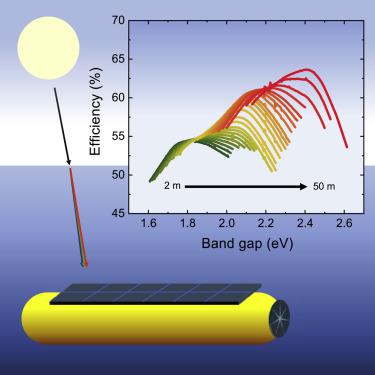Joule ( IF 38.6 ) Pub Date : 2020-03-18 , DOI: 10.1016/j.joule.2020.02.005 Jason A. Röhr , Jason Lipton , Jaemin Kong , Stephen A. Maclean , André D. Taylor

|
Operation of underwater vehicles and autonomous systems is currently limited by the lack of long-lasting power sources. These systems could potentially be powered using underwater solar cells, but the material requirements to achieve their full potential are not well understood. Using detailed-balance calculations, we show that underwater solar cells can exhibit efficiencies from 55% in shallow waters to more than 65% in deep waters, while maintaining a power density >5 mW cm−2. We show that the optimum band gap of the solar cell shifts by 0.6 eV between shallow and deep waters and plateaus at 2.1 eV at intermediate depths, independent of geographical location. This wide range in optimum band-gap energies opens the potential for a library of wide-band-gap semiconductors to be used for high-efficiency underwater solar cells. Our results provide a roadmap for proper choice of underwater solar cell materials, given the conditions at points of use.
中文翻译:

水下太阳能电池的效率极限
当前,由于缺乏持久的动力源,水下车辆和自主系统的运行受到限制。这些系统可能会使用水下太阳能电池供电,但是对于充分发挥其潜能的材料要求却知之甚少。使用详细的余额计算,我们表明,水下太阳能电池可以发挥以下作用在保持功率密度> 5 mW cm -2的同时,在浅水区中占55%,在深水区中占65%以上。我们表明,太阳能电池的最佳带隙偏移了浅水和深水与高原之间的0.6 eV 2.1 eV在中间深度,与地理位置无关。最佳带隙能量的这一宽泛范围为用于高效水下太阳能电池的宽带隙半导体库提供了潜力。根据使用条件,我们的结果提供了正确选择水下太阳能电池材料的路线图。










































 京公网安备 11010802027423号
京公网安备 11010802027423号